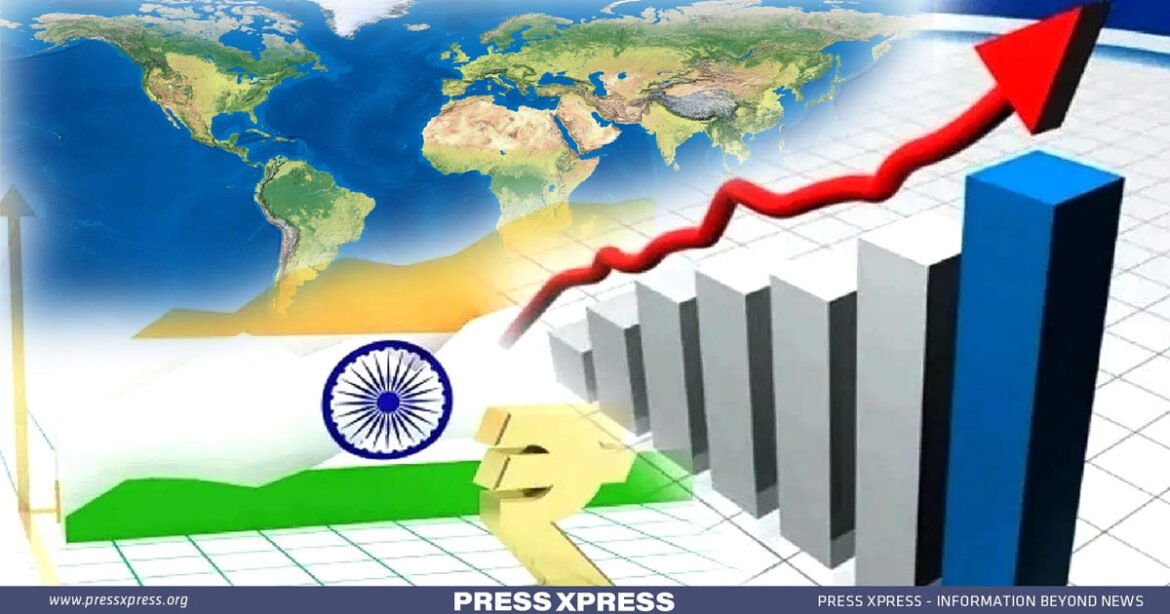With robust growth, visionary leadership, and strategic initiatives, India charts a path toward economic dominance
India’s economic journey is a tale of resilience, transformation, and ambition. From its roots as a mixed-planned economy to its current status as a burgeoning social market powerhouse, India has emerged as a key player on the global stage. With the largest economy in South Asia and ranking fifth globally by nominal GDP and third by purchasing power parity (PPP), India’s economic prowess is undeniable. However, challenges persist as the nation strives to unlock its full potential.
You Can Also Read: India Election 2024: World’s Largest Election Kicks Off
Since the turn of the 21st century, India has maintained an impressive annual GDP growth rate of 6% to 7%, reflecting its robust economic foundation. Yet, the path to prosperity is paved with obstacles. As India charts its course towards economic superpower status, addressing these challenges becomes paramount.
Driven by the visionary leadership of Prime Minister Modi, ambitious infrastructure projects, and strategic initiatives to attract global investment, India’s trajectory toward economic dominance is palpable. Yet, sustainable growth requires a concerted effort to bridge divides, invest in human capital, and navigate geopolitical complexities. As India navigates these challenges, its journey toward becoming a global economic powerhouse continues, fueled by resilience, innovation, and unwavering determination.
Factors in Favour of India’s Rise as a Superpower
Factors in favor of India’s rise as a superpower are discussed below:
India’s Economic Growth Trajectory
One of the world’s economies exhibiting rapid growth is India. India’s economy has undergone a significant transformation, transitioning from a mixed-planned economy to a mixed middle-income developing social market economy. On a per capita income basis, India ranked 139th by nominal GDP and 127th by PPP, according to the International Monetary Fund (IMF).
Historically, the Indian subcontinent boasted the largest economy in the world for most of recorded history until the onset of colonialism in the early 19th century. In 2022, India accounted for 7.2% of the global economy in PPP terms and around 3.4% in nominal terms. In 2023, India’s economy was valued at $3.7 trillion, making it the fifth-largest globally, having climbed four positions during Modi’s ten-year tenure. Between 2014 and 2023, India’s per capita GDP experienced a 55% increase. During this period, the country progressed from being the ninth-largest economy to the fifth-largest and demonstrated the most substantial GDP growth compared to other major economies.
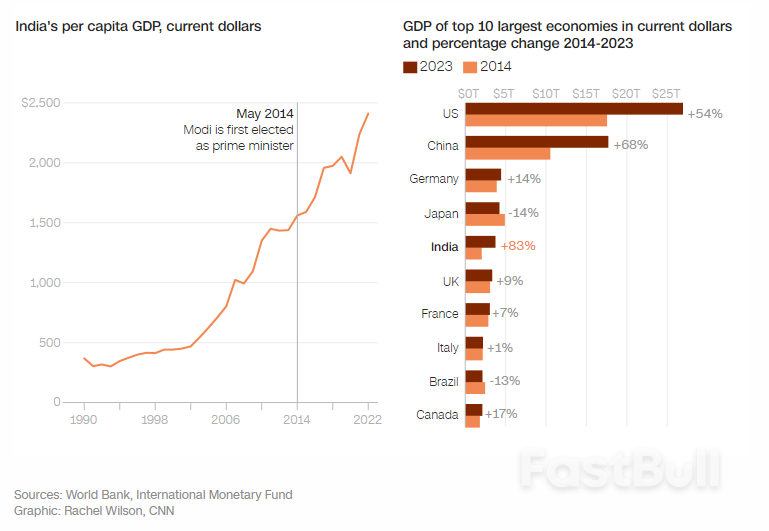
The South Asian giant’s economy is well-positioned to sustain an annual expansion rate of at least 6% in the upcoming few years. However, analysts suggest that India should aim for growth of 8% or higher to become an economic superpower.
Consistent expansion will propel India further up the ranks of the world’s largest economies, with some observers projecting that the country will become the third-largest by 2027, trailing only the US and China.
Nonetheless, India has significant potential to enhance its gross domestic product (GDP) per capita, a measure of living standards in which it ranked a modest 147 in 2022, according to the World Bank.
Economic Expansion Through Infrastructure
Modi is spending billions on connecting and building modern India. Akin to China’s undertakings over three decades ago, India has initiated a massive infrastructure overhaul by investing billions in constructing roads, ports, airports, and railways. Concurrently, private investors are erecting the world’s largest green energy plant.
In this year’s (2024) federal budget alone, $134 billion was allocated for capital expenditure to bolster economic expansion.
The results of these efforts are tangible, with frenetic construction activities unfolding across the nation. Between 2014 and 2023, India augmented its national highway network by nearly 55,000 kilometers (approximately 35,000 miles), marking a 60% increase in overall length. Infrastructure development offers numerous advantages for the economy, including job creation and improving the ease of doing business.
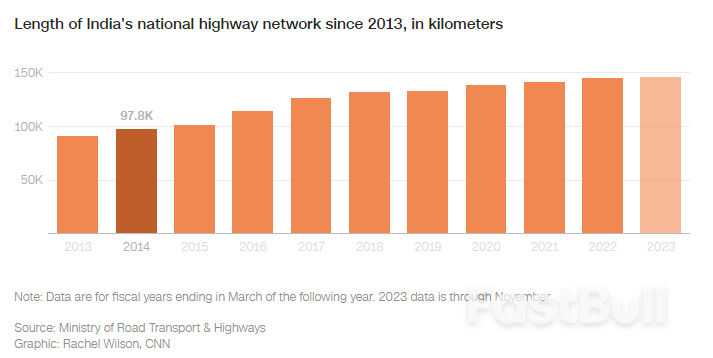
In recent years, the country has also developed a range of tech platforms — referred to as digital public infrastructure — that have transformed the lives and businesses of its citizens.
For instance, the Aadhaar program, launched in 2009, has provided millions of Indians with proof of identity for the first time. This world’s largest biometric database has also enabled the government to save substantial amounts by reducing corruption in welfare initiatives.
Another platform, the Unified Payments Interface (UPI), allows users to make instant payments by scanning a QR code. It has been embraced by Indians from all walks of life, from coffee shop owners to beggars, facilitating the flow of millions of dollars into the formal economy.
In September 2023, citing a World Bank report, Modi stated that thanks to its digital public infrastructure, ‘India has achieved financial inclusion targets in just six years, which would otherwise have taken at least 47 long years’.
India’s Stock Exchange Dominance
India’s stock market has surged to record highs, reflecting optimism about its growth potential. Valued at over $4 trillion, India’s exchanges, including the National Stock Exchange (NSE) and the BSE, have seen remarkable growth. The NSE has even surpassed the Shenzhen and Hong Kong exchanges to become the world’s sixth largest, as demonstrated by data from the World Federation of Exchanges in January.
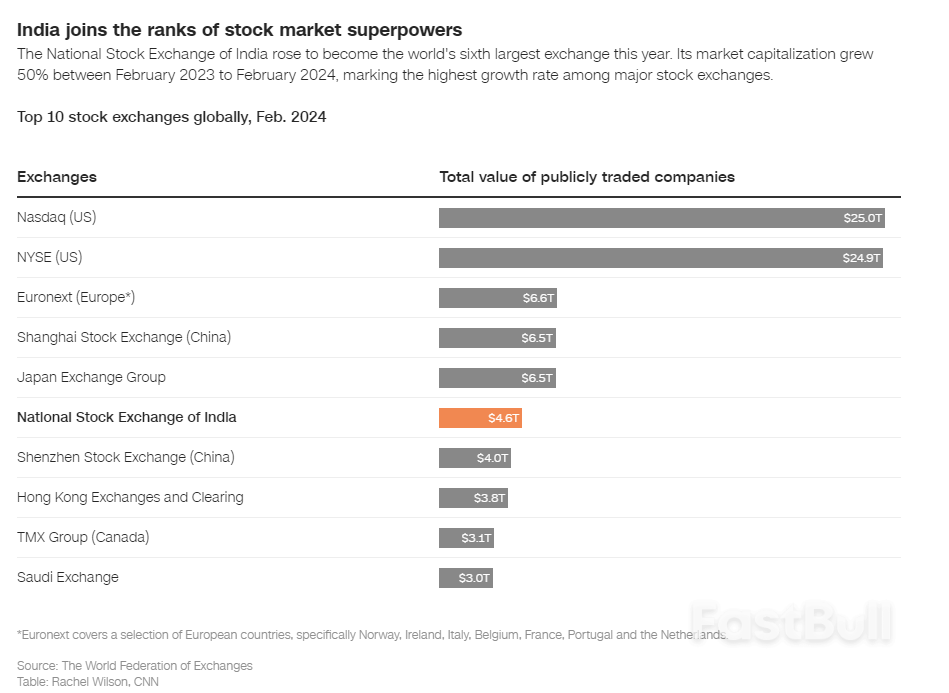
Both retail and institutional investors are fueling this rally, with retail investors alone holding 9% of the market value. While foreign investment is currently below 20%, analysts anticipate an uptick post-election in the latter half of 2024.
Modi’s Supply Chain Strategy
The Modi government is actively leveraging the current reevaluation of supply chains by companies, aiming to attract them to India amid a desire to diversify away from China. To this end, India has introduced a $26 billion production-linked incentive program across 14 sectors. Major firms like Foxconn are expanding operations in response, with Elon Musk expressing interest in meeting Modi to potentially announce a significant investment by Tesla in India.
Notably, Apple has accelerated its manufacturing presence in India, now assembling new iPhone models there shortly after launch. Analysts view this shift positively, seeing it as a boon for Modi’s efforts to bolster manufacturing ties with global players like Apple, which could further attract investment in India’s electronics manufacturing sector. By 2025’s end, Canalys predicts that India will manufacture approximately 23% of iPhones, marking a substantial rise from the 6% recorded in 2022.
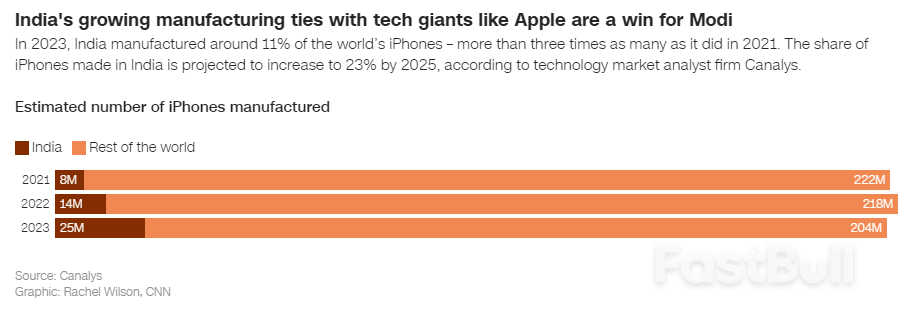
Obstacles Impeding India’s Superpower Ascent
Although the economy of India is fast-growing, India’s economy, much like its democracy, is still far from perfect. If re-elected, Modi has to tackle the enormous challenges.
India’s Youth Unemployment Challenge: India faces the challenge of creating millions of jobs for its predominantly impoverished population. Despite having one of the youngest populations globally, with an average age of 29, the country struggles to harness the economic potential of its youth. A recent report from the International Labour Organization highlights that educated Indians aged 15 to 29 face higher unemployment rates than those without formal education, indicating a gap between aspirations and available opportunities. Youth unemployment rates in India surpass global levels, with graduates experiencing particularly high rates, exceeding 29%. This disparity underscores the need for policies that address skills mismatches and enhance job creation to unlock the full potential of India’s youthful demographic.
Infrastructure Deficits: India faces an annual infrastructure investment gap of $200 billion according to the Economic Survey 2022-23, which hinders growth and connectivity.
Poverty and Inequality: Despite progress, 139.9 million Indians lived below the national poverty line in 2021 according to the World Bank. India’s Gini coefficient was 35.7 in 2011, indicating high income inequality.
Educational and Skill Gaps: According to UNESCO, India’s literacy rate was 77.7% in 2021. Only 27.1% of the workforce received formal skill training in 2019-20, according to the Periodic Labour Force Survey (PLFS).
Environmental Challenges: According to the IEA, India was the third-largest emitter of greenhouse gases in 2022. 21 Indian cities ranked among the world’s 30 most polluted in 2022 according to IQAir.
Bureaucratic Inefficiencies: India ranked 63rd out of 190 economies in the Ease of Doing Business 2020 report (World Bank), hampered by red tape.
Regional Disparities: The per capita income of the richest state (Goa) was 3.6 times higher than the poorest (Bihar) in 2020-21 according to the Reserve Bank of India.
Geopolitical Tensions: Ongoing border disputes with China and Pakistan divert resources from development.
Healthcare Challenges: India’s healthcare expenditure was only 1.8% of GDP in 2021, according to the World Bank, impacting human capital development.
Corruption and Governance Issues: India scored 40/100 in the 2022 Corruption Perceptions Index, according to Transparency International, indicating persistent governance challenges.
Addressing these multifaceted obstacles through comprehensive reforms, policies, and sustained efforts is crucial for India to realize its full potential as a global superpower.
In Conclusion, India’s economic journey epitomizes resilience and ambition, propelling it to the forefront of the global stage. With robust growth, visionary leadership, and strategic initiatives, India charts a path toward economic dominance.
Following this economic growth of India, on Friday (March 1, 2024), Subramanian, who formerly served as the chief economic advisor to the Indian government, stated on CNBC’s ‘Squawk Box Asia’ that India is set to achieve approximately 8% growth this year, based on the GDP figures.”
However, to overcome challenges and unlock its full potential, sustained efforts in bridging divides, investing in human capital, and navigating complexities are imperative.

